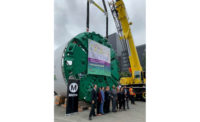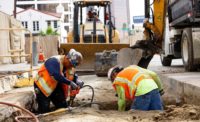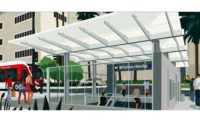The Los Angeles County Metropolitan Transportation Authority unveiled two new tunnel boring machines on June 17 for the authority’s $9.3-billion Purple Line Extension (PLE) project, which will connect subway transit service from downtown Los Angeles to the city’s westside by 2027.
The new TBMs will be used to dig two subway tunnels between downtown, and the Los Angeles neighborhood and business district Century City and the city of Beverly Hills for Section 2 of the 9-mile subway extension project. Section 2, of three, broke ground in February and will include 2.59 miles of track with two new Metro stations, Wilshire/Rodeo and Century City/Constellation.
Metro received the cutterhead and shield for its TBMs, now staged at Metro’s Century City Station construction yard, where they will be built before digging eastward to Wilshire/La Cienega in Beverly Hills. Tutor Perini O&G, Metro’s Section 2 contractor, is building this portion of the project.
Manufactured in Germany by Herrenknecht AG, the TBMs each weigh 1,000 tons and are 400 ft long and 21.75 ft in diameter. Metro expects the Section 2 TBMs to advance 60 ft per day and operate tunnel five days per week, 20 hours per day for a projected 2 years to completion. Tunnel depths will range from 50 ft to 120 ft.
W. Dave Rogstad, president and chief executive officer of Frontier-Kemper Constructors, Inc., part of the joint venture with Tutor-Perini, said the PLE Section 2 machines are Earth Pressure Balance (EPB) TBMs and were designed specifically for the gassy conditions and geology the contractors expect to encounter in the Los Angeles Basin, which is comprised of a sediment mixture of sand, silt and clay.
Rogstad said because PLE Sections 2 and 3 require special tunnel lining designs for fault crossings, precast concrete linings will vary across the project.
“Special design and testing is required for the fault lining sections to prevent any ingress of soil in the event of fault movement,” Rogstad said. “A combination of concrete and steel hybrid linings have been developed to meet the design criteria.”
The PLE Section 1 TBMs were also designed specifically for their route, said Richard A. McLane, Traylor Bros., Inc.’s tunnel construction manager for PLE Section 1, construction of which was awarded to a joint venture of Skanska, Traylor Bros., Inc., and Shea.
"The short-short story is first and foremost geology: PLE Section 1 has several different types of geology, San Pedro (sand, coarse and fine), Fernando (silt stone), and tar impacted (bitumen) soils,” said McLane, who said a slurry TBM and separation plant would struggle through the Fernando due to the heavy fines content with very slow production rates of only 45 ft per day.
“It was also questionable that the separation plant would be able to remove the tar from the bentonite slurry,” McLane said. Section 1 of the PLE runs through Los Angeles’ Westside, home of the La Brea Tar Pits, the asphalt seeps of which are the only consistently active and urban Ice Age excavation site in the world.
“Our testing showed that clogging was most likely to happen. We carried out extensive testing with soil conditioners to prove the tar saturated soils could be conditioned into an earth paste which could be used with an EPB TBM.”
The Purple Line’s expansion reached a major milestone last October, when two TBMs began carving out twin tunnels for the project’s Section 1, which will complete next year, and Rogstad expects the Section 2 TBMs to launch late this year, followed by the Section 3 machines, which will launch in late summer 2020.
“There will be times over the next few years that up to four machines will be mining simultaneously — I doubt it will be higher than that as I expect the PL1 machines will be done before the PL3 machines start,” said Rogstad, who noted that the TBMs are owned by the contractors, who will decide what to do with their machines upon completion.
“It is certainly likely they will be rebuilt for future projects,” Rogstad said.
When complete in 2027, the Purple Line will connect Metro’s Wilshire/Western Station, in the city’s Mid-Wilshire/Koreatown’s district, to the westside in 25 minutes, versus a current car or bus commute of one hour or more. The subway extension is expected to increase service by 17,000 new riders; an estimated 60,000 riders currently use the subway daily. The project is funded by ballot-elected sales tax devoted to transportation investments — Measure R approved in 2008 and Measure M in 2016 — and federal grants.
At the unveiling ceremony, Metro also announced student winners of contests naming the TBMs and illustrating their tail shields. Sixth-grader Ruby Santamaria’s winning entries for “Harriet” and “Ruth” were named after abolitionist and Underground Railroad “conductor” Harriet Tubman and U.S. Supreme Court Justice Ruth Bader Ginsberg. Third-grader Hans Smallwood’s illustration rendering the PLE subway under Rodeo Drive won the art contest.
Created in 1993, Metro is a multimodal transportation agency that transports 1.3 passengers on 2,200 clean air buses and six rail lines.





Post a comment to this article
Report Abusive Comment